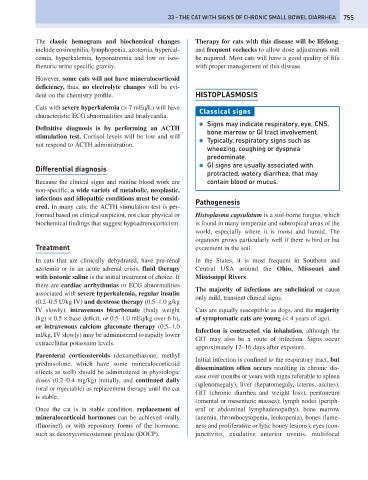Page 763 - Problem-Based Feline Medicine
P. 763
33 – THE CAT WITH SIGNS OF CHRONIC SMALL BOWEL DIARRHEA 755
The classic hemogram and biochemical changes Therapy for cats with this disease will be lifelong,
include eosinophilia, lymphopenia, azotemia, hypercal- and frequent rechecks to allow dose adjustments will
cemia, hyperkalemia, hyponatremia and low or isos- be required. Most cats will have a good quality of life
thenuric urine specific gravity. with proper management of this disease.
However, some cats will not have mineralocorticoid
deficiency, thus, no electrolyte changes will be evi-
dent on the chemistry profile. HISTOPLASMOSIS
Cats with severe hyperkalemia (> 7 mEq/L) will have
Classical signs
characteristic ECG abnormalities and bradycardia.
● Signs may indicate respiratory, eye, CNS,
Definitive diagnosis is by performing an ACTH
bone marrow or GI tract involvement.
stimulation test. Cortisol levels will be low and will
● Typically, respiratory signs such as
not respond to ACTH administration.
wheezing, coughing or dyspnea
predominate.
● GI signs are usually associated with
Differential diagnosis
protracted, watery diarrhea, that may
Because the clinical signs and routine blood work are contain blood or mucus.
non-specific, a wide variety of metabolic, neoplastic,
infectious and idiopathic conditions must be consid-
Pathogenesis
ered. In many cats, the ACTH stimulation test is per-
formed based on clinical suspicion, not clear physical or Histoplasma capsulatum is a soil-borne fungus, which
biochemical findings that suggest hypoadrenocorticism. is found in many temperate and subtropical areas of the
world, especially where it is moist and humid. The
organism grows particularly well if there is bird or bat
Treatment excrement in the soil.
In cats that are clinically dehydrated, have pre-renal In the States, it is most frequent in Southern and
azotemia or in an acute adrenal crisis, fluid therapy Central USA around the Ohio, Missouri and
with isotonic saline is the initial treatment of choice. If Mississippi Rivers.
there are cardiac arrhythmias or ECG abnormalities
The majority of infections are subclinical or cause
associated with severe hyperkalemia, regular insulin
only mild, transient clinical signs.
(0.2–0.5 U/kg IV) and dextrose therapy (0.5–1.0 g/kg
IV slowly), intravenous bicarbonate (body weight Cats are equally susceptible as dogs, and the majority
(kg) × 0.5 × base deficit, or 0.5–1.0 mEq/kg over 6 h), of symptomatic cats are young (< 4 years of age).
or intravenous calcium gluconate therapy (0.5–1.0
Infection is contracted via inhalation, although the
ml/kg, IV slowly) may be administered to rapidly lower
GIT may also be a route of infection. Signs occur
extracellular potassium levels.
approximately 12–16 days after exposure.
Parenteral corticosteroids (dexamethasone, methyl
Initial infection is confined to the respiratory tract, but
prednisolone, which have some mineralocorticoid
dissemination often occurs resulting in chronic dis-
effects as well) should be administered in physiologic
ease over months or years with signs referable to spleen
doses (0.2–0.4 mg/kg) initially, and continued daily
(splenomegaly), liver (hepatomegaly, icterus, ascites),
(oral or injectable) as replacement therapy until the cat
GIT (chronic diarrhea and weight loss), peritoneum
is stable.
(omental or mesenteric masses); lymph nodes (periph-
Once the cat is in stable condition, replacement of eral or abdominal lymphadenopathy), bone marrow
mineralocorticoid hormones can be achieved orally (anemia, thrombocytopenia, leukopenia), bones (lame-
(fluorinef) or with repository forms of the hormone, ness and proliferative or lytic boney lesions), eyes (con-
such as desoxycorticosterone pivalate (DOCP). junctivitis, exudative anterior uveitis, multifocal

